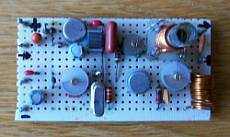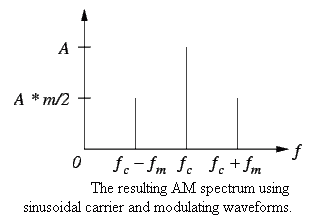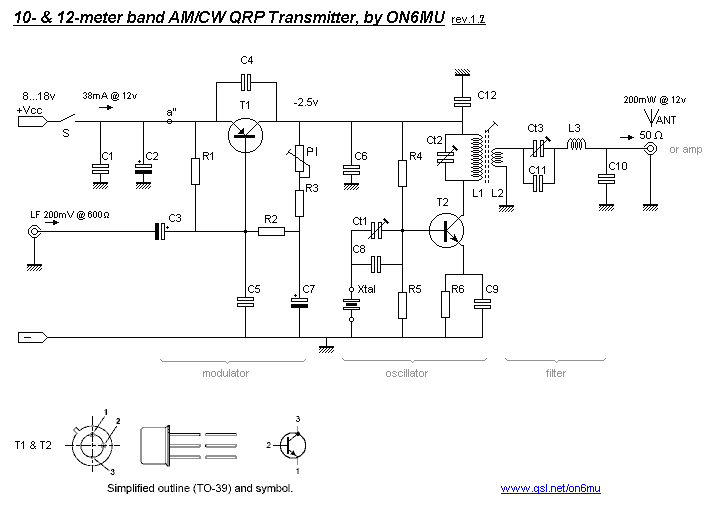QRP AM(cw) Transmitter
for the 12 meterband
RE-TX02HF12

By Guy, de ON6MU
![]()
QRP
AM(cw) Transmitter
for the 12 meterband
RE-TX02HF12

By Guy, de ON6MU
About the QRP AM / cw 12-meter band transmitter
In this project, you will make a
simple low-power broadcast-type circuit, using a crystal
oscillator integrated circuit and an a collector modulated AM
oscillator. You can connect the circuit to the an amplified
microphone (no amplified microphone has a to low output voltage
to work. at least 100...200mv is needed). You could also add a LF
preamp stage of one transistor to allow connecting a microphone
directly.
You'll see that you can receive the signal through the air with
almost any AM radio receiver. Although the circuits used in radio
stations for AM receiving are far more complicated, this
nevertheless gives a basic idea of the concept behind a principle
transmitter. Plus it is a lot of fun when you actually have it
working!
Remember that transmitting on 10 or 12 meter band you'll need a
valid radioamateur license!
A wide range of different circuits have been used for AM, but one
of the simplest circuits uses collector modulation applied via
(for example) a transformer, while it is perfectly possible to
create good designs using solid-state electronics as I applied
here (T1 2N2905).
The transmitter is build as a Colpitts Oscillator with a strong
2N2219(A) transistor. HF-output of the oscillator is 100 to 350
mW, depending on the supply voltage of 9 to 18 Volts. The
transmit frequency is stabilized with the 28Mhz crystal. A slight
detuning of approx 1kc is possible by using Ct1 trimmer
capacitor. The oscillator signal is taken from the collector of
T2 by induction and via a low-feedthrough filter and guided to
the output via an L-filter circuit cleaning up the signal pretty
good. The oscillator is keyed by T1 and the morse key (S). By
keying the morse-key T1 is not been used for modulation and is
biased, hence lets T2 freely oscillate.
AM

Amplitude Modulation (AM) is a process in which the amplitude of
a radio frequency current is made to vary and modify by
impressing an audio frequency current on it.
This was the first type of modulation used for communicating
signals from one point to another and is still the simplest to
understand.
A radio frequency current has a constant amplitude in absence of
modulation and this constant amplitude RF carries no information,
i.e. no audio intelligence and is of no use to radio telephone
(voice communication), but has application in morse code
communication.
In its basic form, amplitude modulation produces a signal with
power concentrated at the carrier frequency and in two adjacent
sidebands. Each sideband is equal in bandwidth to that of the
modulating signal and is a mirror image of the other. Thus, most
of the power output by an AM transmitter is effectively wasted:
half the power is concentrated at the carrier frequency, which
carries no useful information (beyond the fact that a signal is
present); the remaining power is split between two identical
sidebands, only one of which is needed.
CW
CW is the simplest form of modulation. The output of the
transmitter is switched on and off, typically to form the
characters of the Morse code.
CW transmitters are simple and inexpensive, and the transmitted
CW signal doesn't occupy much frequency space (usually less than
500 Hz). However, the CW signals will be difficult to hear on a
normal receiver; you'll just hear the faint quieting of the
background noise as the CW signals are transmitted. To overcome
this problem, shortwave and ham radio receivers include a beat
frequency oscillator (BFO) circuit. The BFO circuit produces an
internally-generated second carrier that "beats"
against the received CW signal, producing a tone that turns on
and off in step with the received CW signal. This is how Morse
code signals are received on shortwave.
Although this design is primarely designed for AM, it can be used
for CW with a slight whistle like sound, but is still usable as
CW transmitter by keying S.
RF Oscillator
Is been carried out by T2 (NPN 2N2219). This is the stage
where the carrier frequency intended to be used is generated by
means of Crystal Oscillator Circuitry or capacitance-inductance
based Variable Frequency Oscillator (VFO). The RF oscillator is
designed to have frequency stability (Xtal) and power delivered
from it is of little importance, although it delivers 250mW@13v ,
hence can be operated with low voltage power supply with little
dissipation of heat.
You could add a switch (very
short connections if using an ordinary switch) to select
different Xtal's (frequencies). You could also use a more
effective diode-based switch I've build here. This hasn't got the problems with
longer connections at all.
Filter
RF power amplification is also done here and this stage is
coupled to the antenna system through antenna impedance matching
circuitry (L1/L2). Care is taken at this stage so that no
harmonic frequency is generated which will cause interference in
adjacent band (splatter) on other bands (Ct3, L3, C10). This
3-element L-type narrow bandpass filter circuit for the desired
frequency cleans out any remaining harmonic signals very
efficiently.
Modulator
Is all done by T1 (PNP 2N2905). Audio information is
impressed upon the carrier frequency at this stage. Do to
selective components circuits (C3, C4, C7, C5) the voice
component frequencies are enhanced, whilest others are suppressed
(bandwidth +- 5kc/side). Important: Modulation depth can be
controled with resistors R2, R3 and P1.
Important: Remember that the modulation must not exceed the
maximum power. This means that you need to set P1 at approx. 50%
the maximum carrier RF power.
Why over modulation is not desirable?..
Over modulation is not desirable, i.e. modulation should not
exceed 100 %, because if modulation exceeds 100 % there is an
interval during the audio cycle when the RF carrier is removed
completely from the air thus producing distortion in the
transmission.
Housing/shielding
The whole circuit needs to be mounted in an
all-metal/aluminum case. If you're unable to obtain an all-metal
case, then use a roll of self-sticking aluminum tape (available
from your hardware store) or PVC box painted with graphite paint.
Just make sure that all individual pieces of aluminum-tape (or
the graphite paint) are conducting with each other. Works fine.
More power
You can connect the output to my power FET based 10-meterband
power amplifier wich should cranck up the power to approx. 3
watt. You'll find it here.
Use it with your receiver
If you put a relay, or better a transistor switch to mute
your receiver (if equiped) you can easily make a QSO HI. A simple
BC338, Bc547, 2N2222 at pin a" with the base biased with a
100k resistor, emmitor at the gnd and the collector fed to your
receiver's mute input works fine. Or you can use a 12v relay...
Every time you PTT the transistor (or when using a relay, the
switch) is "shortened" between the ground, hence muting
your receiver (again; if your receiver has mute capabilities).
Revision 1.1
C12 needs to be connected as close as possible between the gnd
and the L1 cold side (top).

Parts list 12-meterband AM transmitter
T1 2N2905A
T2 2N2219A
C1 100nF
C6 47nF
C4 68nF (polyester)
C2 220uF/25v
C3 2.2uF/25v
C5 10nF (polyester)
C7 2.2uF/25v
C8 12pF
C9 220pF
C10 150pF
C11 10pF
C12 470pF
Ct1= 5...100pF (violet) frequency offset +- 1kc
Ct2= 5...30pF (brown) set at half position and tune at max power
Ct3= 5...40pF (white) set at half position and tune at max power
R1 3k3
R2 1k8 (increase to allow better modulation depth but less continues power)
R3 1k5
P1 1k trimmer (modulation vs power ratio: should be at set to approx. 50% of the maximum carrier)
R4 4k7
R5 1k8
R6 82
L1 = 0.8mm Cul (insulated copper wire), 9 turns close together, 9mm outside diameter (7mm inside)
L2 = 0.8mm Cul (insulated copper wire), 3 turns close together, on same coil holder as L1 with turnable feritte core
L3 = 0.6mm Cul (insulated copper wire), 18 turns, 9mm outside diameter (9mm inside)
Xtal for your desired frequency +- 1kc
C4, C5, C6 polyester film capacitor
W=7mm, H=25mm, L1=9turns, L2=3turns, L3=18turns 9mm diameter
Specifications
Peak Frequency range: 24Mc...26Mc
Output RF
power: 100mW@9v - 200mW@12v - [email protected] - 300mW@16v
measured with max modulation depth
AM modulated
+/- 85% (CW if keyed)
Modulation and maximum power depends highly on how
trimmer P1 is set (read text).
Adjustable output impedance to 50 Ohms
Band-pass type harmonic L-filter
Usable voltages: Vcc 5 - 16 volts
Average current: I 27mA@9v - 38mA@12v - 45mA@16v
Xtal oscillator,
Adjustable frequency of 1Kc
LF input
200mV @ 600 Ohm
Antenna's
It's important to
use a correct designed antenna according to band you would like
to operate, or at least use a good antenna tuner to match the
antenna (protecting your transmitter and proventing
harmonics/interference...). Several examples can be found on my
website and all across the Web. A dipole is always a good
alternative (total length = 150/freq - 5%).
The performance (distance relative to you RF power) of your
antenna is as importent (if not more) as the RF power you
transmit! A dummy load gives also a perfect 1:1 SWR, but you wont
get any farther then the street you live in HI. Finally,
athmospheric conditions (D-,E-,F-layers depending on the
frequency you're using) is equally important to be able to make
DX QSO's.
|
|
Remember that transmitting on 12 meter band (or using homemade transmitters) needs a valid radioamateur license!
Another related
project:10 meterband AM CW transmitter project